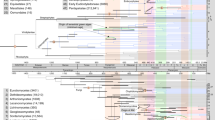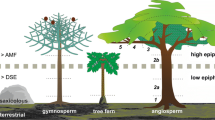Abstract
The oldest fossil evidence of interfungal relationships comes from the Lower Devonian Rhynie chert. However, comprehensive specimens displaying consistent patterns of such associations are rare. In this paper we describe a new interfungal interaction from the Rhynie chert that occurs between two mycelial fungi within a degrading land plant axis. One of the partners (fungus 1, probably a glomeromycete) is represented by aseptate hyphae that extend through the space of what was the cortical intercellular system of the plant and produce thin-walled vesicles and/or spores. Intimately associated with fungus 1 is a second fungus (fungus 2, systematic affinities unknown) comprised of delicate, septate hyphae. Many vesicles/spores of fungus 1 are surrounded by a mantle-like hyphal investment formed by fungus 2. Because fungus 2 invades the vesicles/spores of fungus 1 and forms extensive hyphal wefts in the lumen, we interpret fungus 2 as a parasite, albeit not necessarily a pathogen, of fungus 1. This discovery contributes to our knowledge of the diversity of fungi and the intricate interfungal relationships that existed in early continental ecosystems.




Similar content being viewed by others
References
Błaszkowski J (1995) Glomus corymbiforme, a new species in Glomales from Poland. Mycologia 87:732–737
Boyetchko SM, Tewari JP (1991) Parasitism of spores of the vesicular-arbuscular mycorrhizal fungus, Glomus dimorphicum. Phytoprotection 72:27–32
Bucholtz F (1912) Beiträge zur Kenntnis der Gattung Endogone Link. Beih Bot Centralbl Abt II 29:147–224
Channing A, Edwards D, Sturtevant S (2004) A geothermally influenced wetland containing unconsolidated geochemical sediments. Can J Earth Sci 41:809–827
Combes C (2001) Parasitism. The ecology and evolution of intimate interactions. University of Chicago Press, Chicago
Daniels BA, Menge JA (1980) Hyperparasitization of vesicular-arbuscular mycorrhizal fungi. Phytopathology 70:584–588
Dotzler N, Krings M, Taylor TN, Agerer R (2006) Germination shields in Scutellospora (Glomeromycota: Diversisporales, Gigasporaceae) from the 400 million-year-old Rhynie chert. Mycol Prog 5:178–184
Dotzler N, Walker C, Krings M, Hass H, Kerp H, Taylor TN, Agerer R (2009) Acaulosporoid glomeromycotan spores with a germination shield from the 400-million-year-old Rhynie chert. Mycol Prog 8:9–18
Godfrey RM (1957) Studies of British species of Endogone. II. Fungal parasites. Trans British Mycol Soc 40:136–144
Hass H, Taylor TN, Remy W (1994) Fungi from the Lower Devonian Rhynie chert: mycoparasitism. Amer J Bot 81:29–37
Hijri M, Redecker D, MacDonald-Comber Petetot JA, Voigt K, Wöstemeyer J, Sanders IR (2002) Identification and isolation of two ascomycete fungi from spores of the arbuscular mycorrhizal fungus Scutellospora castanea. Appl Environ Microbiol 68:4567–4573
Jeffries P, Young TWK (1994) Interfungal parasitic relationships. CAB International, Wallingford
Karatygin IV, Snigirevskaya NS, Demchenko KN (2006) Species of the genus Glomites as plant mycobionts in Early Devonian ecosystems. Paleontol J 40:572–579
Kidston R, Lang WH (1921) On Old Red Sandstone plants showing structure, from the Rhynie Chert bed, Aberdeenshire. Part V. The Thallophyta occurring in the peat-bed; the succession of the plants throughout a vertical section of the bed, and the conditions of accumulation and preservation of the deposit. Trans Roy Soc Edinburgh 52:855–902
Krings M, Taylor TN (2013) Zwergimyces vestitus (Kidston et W.H. Lang) nov. comb., a fungal reproductive unit enveloped in a hyphal mantle from the Lower Devonian Rhynie chert. Rev Palaeobot Palynol 190:15–19
Krings M, Taylor TN (2014a) A mantled fungal reproductive unit from the Lower Devonian Rhynie chert that demonstrates Carboniferous “sporocarp” morphology and development. N Jb Geol Paläontol Abh 273:197–205
Krings M, Taylor TN (2014b) An unusual fossil microfungus with suggested affinities to the Chytridiomycota from the Lower Devonian Rhynie chert. Nova Hedw 99:403–412
Krings M, Taylor TN, Hass H, Kerp H, Dotzler N, Hermsen EJ (2007a) An alternative mode of early land plant colonization by putative endomycorrhizal fungi. Plant Signal Behav 2:125–126
Krings M, Taylor TN, Hass H, Kerp H, Dotzler N, Hermsen EJ (2007b) Fungal endophytes in a 400-million-yr-old land plant: infection pathways, spatial distribution, and host responses. New Phytol 174:648–657
Krings M, Dotzler N, Taylor TN (2009) Globicultrix nugax nov. gen. et nov. spec. (Chytridiomycota), an intrusive microfungus in fungal spores from the Rhynie chert. Zitteliana A 48/49:165–170
Krings M, Dotzler N, Longcore JE, Taylor TN (2010) An unusual microfungus in a fungal spore from the Lower Devonian Rhynie chert. Palaeontology 53:753–759
Krings M, Taylor TN, Dotzler N (2013) Fossil evidence of the zygomycetous fungi. Persoonia 30:1–10
Krings M, Taylor TN, Taylor EL, Kerp H, Dotzler N (2014) First record of a fungal “sporocarp” from the Lower Devonian Rhynie chert. Palaeobiodivers Palaeoenviron 94:221–227
Lee PJ, Koske RE (1994) Gigaspora gigantea: parasitism of spores by fungi and actinomycetes. Mycol Res 98:458–466
Maherali H, Klironomos JN (2007) Influence of phylogeny on fungal community assembly and ecosystem functioning. Science 316:1746–1748
Malençon MC (1947) Études de parasitisme mycopathologique. Rev Mycol 7:27–52
Mark DF, Rice CM, Fallick AE, Trewin NH, Lee MR, Boyce A, Lee JKW (2011) 40Ar/39Ar dating of hydrothermal activity, biota and gold mineralization in the Rhynie hot-spring system, Aberdeenshire, Scotland. Geochim Cosmochim Acta 75:555–569
Mark DF, Rice CM, Trewin NH (2013) Discussion on ‘A high-precision U–Pb age constraint on the Rhynie Chert Konservat-Lagerstätte: time scale and other implications’ Journal, Vol. 168, 863–872. J Geol Soc London 170:701–703
Ouellette OPGB [Ed.] (1994) Histological studies of host penetration and colonization by endophytic fungi. American Phytopathological Society Press, St Paul MN
Parry SF, Noble SR, Crowley QG, Wellman CH (2011) A high-precision U-Pb age constraint on the Rhynie chert Konservat-Lagerstätte: time scale and other implications. J Geol Soc London 168:863–872
Parry SF, Noble SR, Crowley QG, Wellman CH (2013) Reply to Discussion on ‘A high-precision U–Pb age constraint on the Rhynie Chert Konservat-Lagerstätte: time scale and other implications’ Journal, Vol. 168, 863–872. J Geol Soc London 170:703–706
Paulitz TC, Menge JA (1986) The effects of a mycoparasite on the mycorrhizal fungus Glomus deserticola. Phytopathology 76:351–354
Petitberghien P (1956) Les champignons hypogés de la region de Dijon. Bull sci Bourgogne 16:115–155
Powell CL, Trewin NH, Edwards D (2000) Palaeoecology and plant succession in a borehole through the Rhynie cherts, Lower Old Red Sandstone, Scotland. In: Friend PF, Williams BPJ (eds) New perspectives on the Old Red Sandstone (Geol Soc London Spec Publ 180). Geological Society Publishing House, Bath, UK, pp 439–457
Purin S, Rillig MC (2008) Parasitism of arbuscular mycorrhizal fungi: reviewing the evidence. FEMS Microbiol Lett 279:8–14
Remy W, Hass H (1996) New information on gametophytes and sporophytes of Aglaophyton major and inferences about possible environmental adaptations. Rev Palaeobot Palynol 90:175–193
Remy W, Taylor TN, Hass H, Kerp H (1994) Four hundred-million-year-old vesicular arbuscular mycorrhizae. Proc Natl Acad Sci U S A 91:11841–11843
Rice CA, Ashcroft WA (2004) The geology of the northern half of the Rhynie basin, Aberdeenshire, Scotland. Trans Roy Soc Edinburgh Earth Sci 94:299–308
Rice CM, Trewin NH, Anderson LI (2002) Geological setting of the Early Devonian Rhynie cherts, Aberdeenshire, Scotland: an early terrestrial hot spring system. J Geol Soc London 159:203–214
Rousseau A, Benhamou N, Chet I, Piché Y (1996) Mycoparasitism of the extramatrical phase of Glomus intraradices by Trichoderma harzianum. Phytopathology 86:434–443
Strullu-Derrien C, Kenrick P, Pressel P, Duckett JG, Rioult JP, Strullu DG (2014) Fungal associations in Horneophyton ligneri from the Rhynie Chert (c. 407 million year old) closely resemble those in extant lower land plants: novel insights into ancestral plant–fungus symbioses. New Phytol 203:964–979
Sylvia DM, Schenck NC (1983a) Germination of chlamydospores of three Glomus species as affected by soil matric potential and fungal contamination. Mycologia 75:30–35
Sylvia DM, Schenck NC (1983b) Soil fungicides for controlling chytridiaceous mycoparasites of Gigaspora margarita and Glomus fasciculatum. Appl Environ Microbiol 45:1306–1309
Taber RA (1982) Gigaspora spores and associated hyperparasites in weed seeds in soil. Mycologia 74:1026–1031
Taylor TN, Remy W, Hass H (1992) Fungi from the Lower Devonian Rhynie chert: Chytridiomycetes. Amer J Bot 79:1233–1241
Taylor TN, Remy W, Hass H, Kerp H (1995) Fossil arbuscular mycorrhizae from the Early Devonian. Mycologia 87:560–573
Taylor TN, Klavins SD, Krings M, Taylor EL, Kerp H, Hass H (2004) Fungi from the Rhynie chert: a view from the dark side. Trans Roy Soc Edinburgh Earth Sci 94:457–473
Taylor TN, Hass H, Kerp H (2005) Life history biology of early land plants: deciphering the gametophyte phase. Proc Natl Acad Sci U S A 102:5892–5897
Wakefield WS, Powell MS, Letcher PM, Barr DJS, Churchill PF (2010) A molecular phylogenetic evaluation of the Spizellomycetales. Mycologia 102:596–604
Wellman CH (2006) Spore assemblages from the Lower Devonian ‘Lower Old Red Sandstone’ deposits of the Rhynie outlier, Scotland. Trans Roy Soc Edinburgh Earth Sci 97:167–211
Wellman CH, Kerp H, Hass H (2006) Spores of the Rhynie chert plant Aglaophyton (Rhynia) major (Kidston & Lang) Edwards 1986. Rev Palaeobot Palynol 142:229–250
Yao YJ, Pegler DN, Young TWK (1996) Genera of Endogonales. Royal Botanic Gardens, Kew
Acknowledgments
This study was supported by funds from the National Science Foundation (EAR-0949947), the Deutsche Forschungsgemeinschaft (Ke 584/13-2), and the Alexander von Humboldt-Foundation (V-3.FLF-DEU/1064359). We thank U. Projahn, S. Sónyi, H. Martin, and N. Dotzler (all Munich) for technical assistance. The paper benefited from the constructive comments and suggestions of two anonymous referees.
Author information
Authors and Affiliations
Corresponding author
Rights and permissions
About this article
Cite this article
Krings, M., Taylor, T.N. Deciphering interfungal relationships in the 410-million-yr-old Rhynie chert: an intricate interaction between two mycelial fungi. Symbiosis 64, 53–61 (2014). https://doi.org/10.1007/s13199-014-0302-2
Received:
Accepted:
Published:
Issue Date:
DOI: https://doi.org/10.1007/s13199-014-0302-2




